For sun-baked potato dishes, you'll want to dice your potatoes into 1/2-inch to 3/4-inch uniform cubes. This size strikes the perfect balance between quick cooking and moisture retention in solar ovens, which typically reach 200-350°F. Before cutting, wash and thoroughly dry your potatoes to guarantee ideal crispiness. Use a sharp chef's knife and create a flat base for stability while dicing. Position your solar cooker southeast in the morning and rotate it around 12:30 PM for the best results. Cook between 11 AM and 3 PM when sun intensity peaks. There's much more to mastering the art of solar potato preparation than just the perfect dice size.
Understanding Solar Cooking Heat Distribution
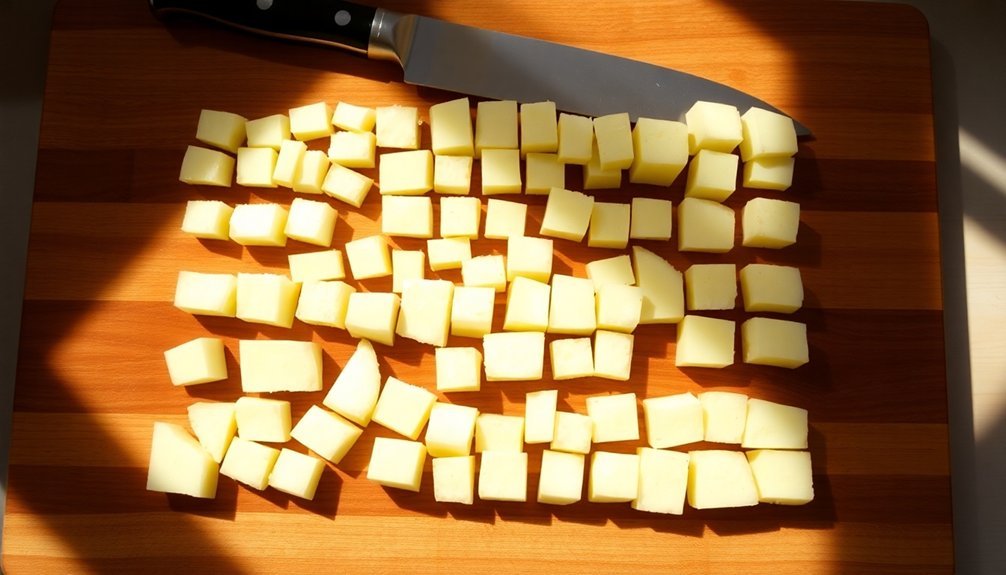
While solar cooking may seem complex at first, it relies on a straightforward process of converting the sun's UV rays into usable heat energy. When these rays enter your solar cooker, they transform into infrared radiation that heats your food by making its water, fat, and protein molecules vibrate.
You'll need to focus on four key elements for effective heat distribution.
First, position reflective panels to concentrate the sun's rays onto your cooking area, adjusting them every 30-60 minutes.
Second, use dark-colored cookware to maximize heat absorption.
Third, guarantee your cooker has proper insulation to retain heat. For optimal insulation, newspaper and cotton balls can be used as effective materials.
Finally, cover your cooker with a transparent lid that allows sunlight in while trapping the heat inside. This greenhouse effect maintains consistent cooking temperatures regardless of outside conditions.
Optimal Dice Sizes For Sunlight
When you're cooking potatoes outdoors, the size of your cuts matters greatly for solar cooking success.
You'll want to opt for small dice cuts (1/4 inch) when seeking quick results in direct sunlight, as they heat more efficiently and develop better texture.
For longer solar oven cooking sessions, however, larger 3/4-inch chunks work better since they maintain their structure while cooking slowly and evenly in the contained heat. Since solar ovens typically reach 200 to 350 degrees Fahrenheit, these larger cuts allow for thorough cooking without becoming mushy.
Small Dice Benefits Outside
Because outdoor cooking presents unique challenges, small diced potatoes offer significant advantages when preparing sun-baked dishes. You'll find that smaller pieces cook more evenly and are less likely to burn under direct sunlight, helping you achieve consistent results every time.
When you're cooking potatoes outdoors, small dice provide essential benefits:
- Retains moisture better due to lower surface-to-volume ratio, keeping your potatoes tender
- Reduces cooking time, minimizing exposure to intense sun rays
- Prevents uneven browning and harmful compound formation
- Allows for versatile use in various outdoor recipes, from salads to roasts
Similar to how shade-tolerant vegetables thrive with minimal sun exposure, your small-diced potatoes will distribute heat more effectively throughout the dish while maintaining their natural color and texture.
This size also makes it easier to combine potatoes with other ingredients, creating well-balanced sun-baked dishes.
Chunky Cuts Under Sun
Although small dices excel in many outdoor dishes, chunky potato cuts measuring 3/4 to 1 inch thick can deliver superior results under direct sunlight.
You'll find these larger pieces absorb seasonings better while creating an appealing contrast between their crispy exterior and creamy interior.
When you're preparing chunky cuts for sun-baking, you'll want to arrange them in a single layer and roast them at temperatures between 450°F and 500°F.
Don't forget to flip them regularly for even browning. You can enhance their flavor by tossing them in butter and herbs before cooking, and basting them with broth during the process keeps them moist.
For the best results, let your chunky potatoes rest briefly after cooking.
They're easier to handle than smaller cuts and create a rustic, homemade appearance in your dish.
Preparation Tools And Techniques
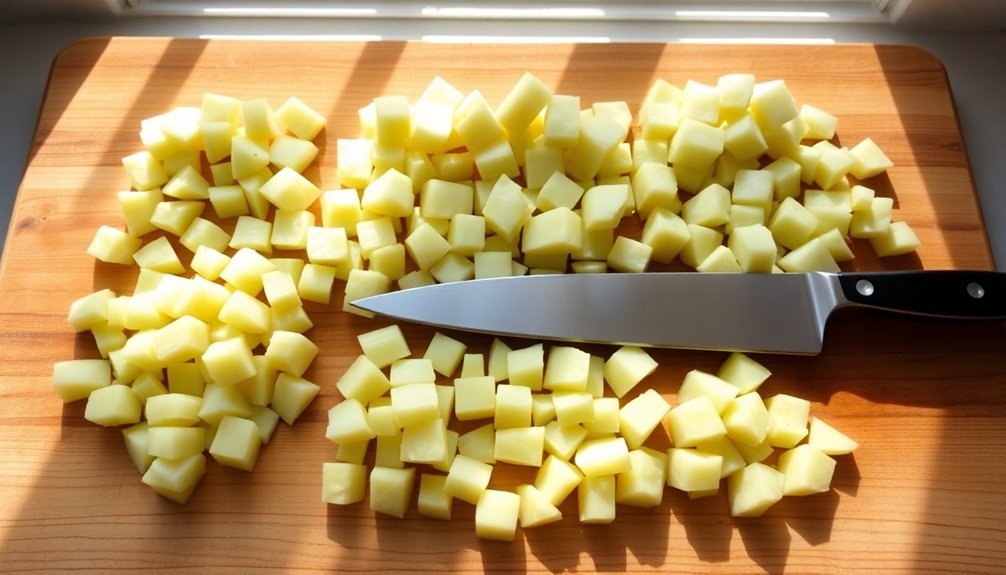
The right preparation tools and techniques form the foundation of perfect potato dicing. You'll need a sharp chef's knife, sturdy cutting board, and vegetable peeler to get started. For stability, place a damp paper towel under your board to prevent slipping while you work.
Begin by washing and drying your potatoes thoroughly. If your recipe calls for peeled potatoes, remove the skin and trim the ends. Create a flat base by cutting a strip lengthwise – this guarantees stability for precise cutting.
For sun-baked dishes, you'll want to take into account these essential cutting techniques:
- Slice lengthwise into uniform pieces
- Transform slices into batons by cutting strips
- Create cubes by cutting across the batons
- Stack similar-sized pieces to speed up the process
Solar Cooking Time Guidelines
Once you've diced your potatoes to the perfect size, mastering solar cooking times becomes your next focus. You'll want to dice your potatoes smaller for faster cooking, as larger pieces can take up to 3 hours in a solar oven. For ideal results, cook between 11:00 am and 3:00 pm when the sun's intensity peaks.
| Time of Day | What You Should Do |
|---|---|
| Morning | Position cooker facing southeast |
| 11:00 AM | Begin cooking, guarantee direct sunlight |
| 12:30 PM | Rotate cooker to track sun |
| 2:00 PM | Check potato tenderness |
| 3:00 PM | Final adjustments if needed |
Remember that dark, non-shiny cookware will speed up your cooking time. You'll need to adjust your cooker every 30-60 minutes for the best results, unless you've set it to track the sun's path automatically.
Seasoning Methods For Solar Dishes
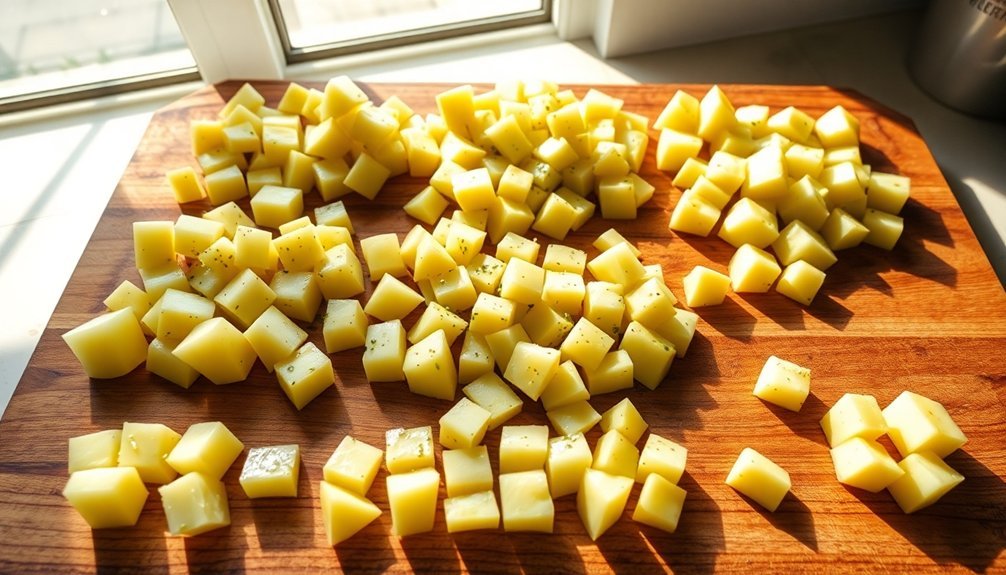
Seasoning your solar-cooked dishes properly can transform a simple meal into a flavorful feast. You'll want to prepare your seasoning mix ahead of time in a single container for easy transport and application.
For potatoes, combine classic spices like paprika, garlic powder, and cayenne for a smoky kick, then finish with butter after cooking.
When preparing meat and vegetable combinations, you'll find success with these essential seasonings:
- Cumin and garlic salt for a savory base
- Italian herbs and nutmeg for aromatic depth
- Worcestershire sauce or bouillon for umami notes
- Fresh aromatics like onion and garlic
Don't forget to marinate your ingredients beforehand, allowing the flavors to penetrate deeply.
For convenience, you can even use beef Ramen spice packets as a quick flavoring solution.
Moisture Control While Sun Cooking
Maintaining proper moisture levels while sun cooking requires careful attention to both environmental conditions and food preparation techniques.
You'll want to monitor humidity levels between 30-60% for best results, as higher moisture can slow down cooking and increase spoilage risks.
To control moisture effectively, you'll need proper ventilation with 1-2 mph airflow.
Set up your cooking area with low intake vents and high exhaust vents to create natural convection.
If you're using a solar dehydrator, adjust the vent openings to maintain ideal temperatures above 85°F.
Keep your food protected from unexpected rain and nighttime condensation.
Use screens or netting to prevent insects while allowing proper airflow.
When moisture levels rise, you can increase ventilation or temporarily reduce portion sizes to maintain consistent cooking conditions.
Arranging Diced Potatoes For Success
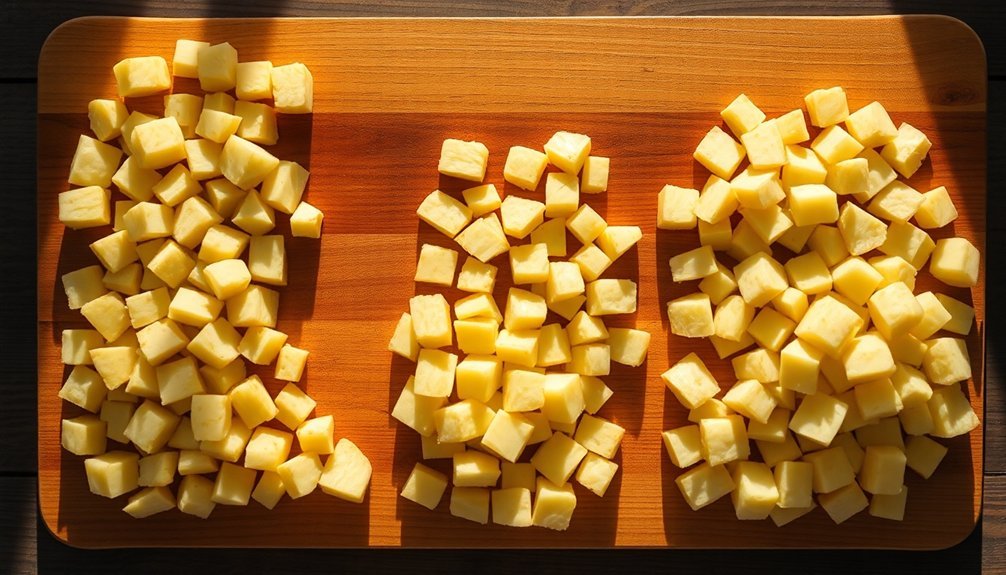
Proper arrangement of diced potatoes can make or break your roasting results. You'll want to start by greasing your baking sheet to prevent any unwanted sticking during the cooking process.
When placing your diced potatoes, it's essential to arrange them in a single layer with adequate spacing between pieces.
For ideal results, consider these key arrangement tips:
- Use a baking sheet large enough to prevent overcrowding
- Leave about 1/4 inch of space between each potato piece
- Make certain no potatoes are stacked on top of each other
- Create consistent spacing for even air circulation
This thoughtful arrangement allows hot air to flow freely around each piece, promoting uniform browning and the perfect crispy exterior you're aiming for.
Frequently Asked Questions
Can I Use Sweet Potatoes Instead of Regular Potatoes for Sun-Baked Dishes?
Yes, you can use sweet potatoes for sun-baked dishes. They'll need about 8 hours of full sunlight, and while they won't get crispy skin, you'll get a light, fluffy texture that's similar to oven-baked results.
How Do Cloudy Days Affect the Texture of Diced Potatoes?
When potatoes grow during cloudy days, they'll develop more consistent moisture content, affecting how they dice. You'll notice your diced potatoes have an even texture, though excessive cloudiness can make them too wet and mushy.
Should Potatoes Be Pre-Soaked Before Sun-Baking to Prevent Browning?
You don't need to pre-soak potatoes before sun-baking to prevent browning. While pre-soaking can reduce acrylamide, it may actually make your potatoes less crispy. Just cut them right before cooking for best results.
Does Altitude Affect the Dicing Size Requirements for Solar Cooking?
No, you don't need to adjust your dicing size based on altitude for solar cooking. While altitude affects cooking time and moisture loss, your cutting size should be based on recipe requirements and desired texture instead.
Can Frozen Diced Potatoes Be Used in Solar Cooking Methods?
Yes, you can use frozen diced potatoes in solar cooking, but you'll need to account for longer cooking times and potential texture changes. It's best to thaw them first for more consistent results.
In Summary
You'll find sun-baked potato dishes turn out best when you've diced your spuds into consistent 1/2 to 3/4-inch cubes. Remember to spread them evenly in a single layer and rotate your solar cooker every 30 minutes for ideal heat distribution. Don't forget to lightly oil your cooking surface and season before cooking. With proper moisture control and arrangement, you're guaranteed tender, evenly cooked potato bites every time.

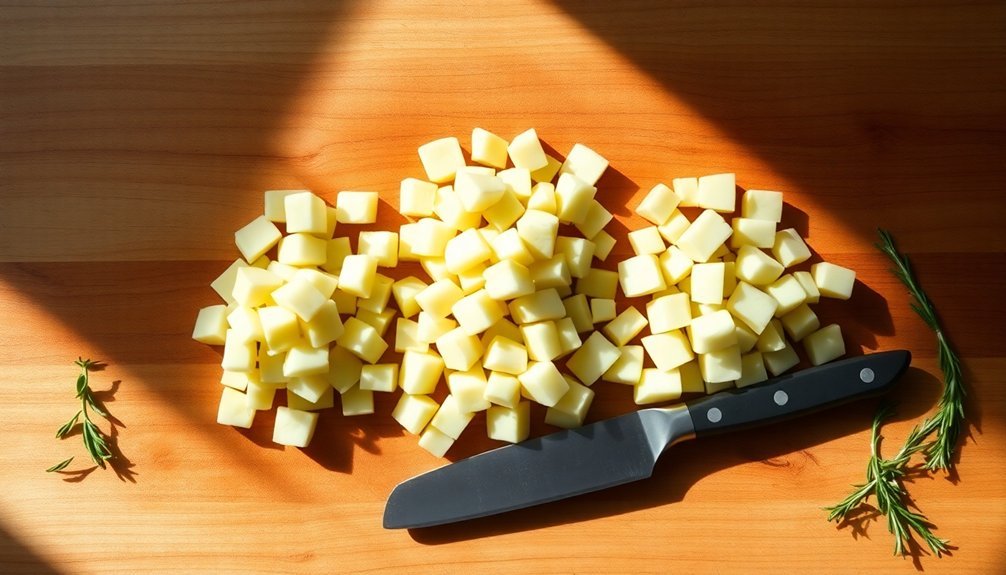



Leave a Reply